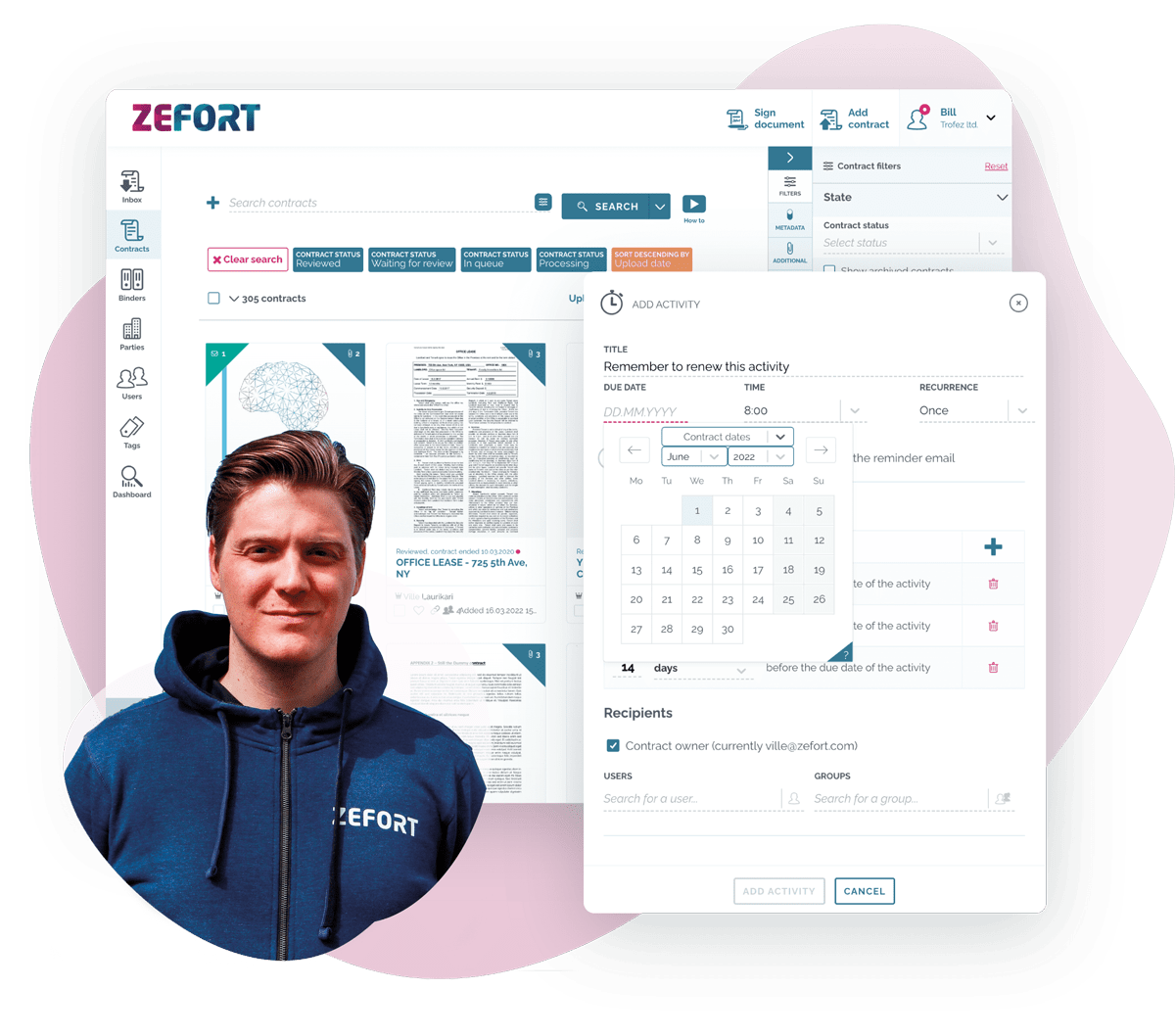Contracts are an integral part of our personal and professional lives, governing agreements, commitments, and obligations. But the journey of a contract doesn’t start or end with a signature. Enter contract lifecycle management (CLM), an essential process that ensures contracts are effectively handled, from their creation to their completion.
In this article, we will delve into the basics of CLM, unraveling its intricacies, and shedding light on why it’s crucial to understand this often overlooked aspect of contract management.
Definition and Importance of Contract Lifecycle Management
Contract lifecycle management refers to the process of effectively managing the creation, negotiation, execution, and renewal of contracts. It involves various stages, from pre-signing to post-signing, and encompasses tasks such as drafting agreements, reviewing terms and conditions, tracking key dates, and measuring performance. CLM is crucial for organizations as it helps ensure compliance, mitigate risks, improve operational efficiency, and enhance customer and supplier relationships.
For instance, by centralizing contract data and streamlining workflows, businesses can reduce errors, avoid penalties, and optimize contract utilization. Furthermore, CLM tools and processes provide valuable insights for negotiating favorable terms, identifying cost-saving opportunities, and evaluating contract performance against key metrics.
Key Components of Contract Lifecycle Management
Contract Creation
Contract creation is a fundamental step in the contract lifecycle management process. It involves the preparation and drafting of legally binding agreements between two or more parties. This subsection highlights the significance of contract creation and provides practical insights:
- Clear communication: Contracts should be written in a concise and coherent manner, ensuring that all terms and conditions are unambiguous and easily understandable.
- Detailed specifications: The contract should outline specific deliverables, timelines, payment terms, and any other relevant details to avoid misunderstandings or disputes.
- Legal compliance: Contracts must comply with applicable laws and regulations, taking into account industry-specific requirements and any necessary approvals or permits.
- Incorporate protections: Including clauses for confidentiality, intellectual property rights, indemnification, and dispute resolution mechanisms helps safeguard the interests of all parties involved.
- Document control: Maintaining an organized system for contract storage, version control, and access permissions streamlines contract creation and facilitates efficient collaboration.
Contract Negotiation
Contract negotiation involves discussing and finalizing the terms and conditions of the contract between the parties involved. Effective negotiation ensures that both parties’ needs and preferences are addressed, leading to a mutually beneficial agreement.
For example, negotiating the price, duration, or terms of delivery can result in cost savings or improved outcomes. It is important to prepare thoroughly, understand the goals and limitations, and actively listen and communicate during negotiations to achieve a successful outcome.
Contract Execution and Approval
The process of contract execution and approval involves ensuring that contracts are reviewed, finalized, and agreed upon by all relevant parties before they are implemented.
This step is necessary to validate the terms and conditions outlined in the contract and ensure that all parties have a clear understanding of their obligations.
By diligently executing and approving contracts, organizations can mitigate risks, avoid disputes, and maintain strong business relationships. For example, a company may require contracts to be approved by legal counsel to ensure compliance with applicable laws and regulations.
Additionally, an efficient contract execution and approval process can enable organizations to streamline their operations and enhance overall efficiency.
Benefits of Implementing Contract Lifecycle Management
Enhanced Contract Visibility and Control
Enhanced contract visibility and control allow organizations to have a clear understanding of their contracts and ensures that they are being effectively managed.
Without proper visibility, companies may face risks such as missed deadlines, noncompliance, or missed opportunities for cost savings. By having a centralized system and dashboards that provide real-time insights, organizations can proactively identify and address any issues or bottlenecks in the contract process.
Furthermore, enhanced visibility and control enable companies to have better negotiations, track contract performance, and enforce contractual obligations. It ensures that all stakeholders have access to the necessary information, reducing the chances of misunderstandings or disputes.
Improved Compliance and Risk Management
By implementing robust processes and systems, organizations can ensure regulatory adherence and mitigate potential risks. This includes maintaining up-to-date contracts, tracking key milestones, and monitoring performance metrics. For instance, automating compliance checks can help identify contract violations more efficiently, reducing the risk of non-compliance penalties.
Additionally, incorporating risk assessment tools can provide better visibility into potential risks associated with specific contract terms or clauses. By enhancing compliance and risk management practices, businesses can safeguard their interests and maintain stronger relationships with partners and stakeholders.
Streamlined Contract Renewal and Termination
Streamlined contract renewal and termination allows organizations to efficiently manage their contracts, ensuring they are renewed or terminated on time. By streamlining this process, companies can avoid unnecessary costs and disputes.
For example, automating contract renewal notifications can help companies track and manage their contracts more efficiently.
Additionally, having a clear termination clause in contracts can provide a straightforward process for ending agreements. By implementing streamlined processes, companies can effectively manage the renewal and termination of their contracts, saving time and resources in the long run.
Challenges in Contract Lifecycle Management
Lack of Standardization and Process Alignment
In contract lifecycle management, the absence of standardization can lead to inefficiencies and inconsistencies across different stages of the contract process. Without a standardized approach, different departments or teams may have varying methods of managing contracts, resulting in confusion and potential errors.
Process alignment, ensuring that all stakeholders are on the same page and following consistent procedures, is crucial for effective contract management. For example, if one department is using a manual process while another is using an automated system, it can lead to miscommunication and delays.
Standardization and process alignment help streamline contract management, improve collaboration, and reduce errors or oversights.
Manual and Fragmented Contract Management Processes
Manual and fragmented contract management processes can pose challenges to organizations during the contract lifecycle management. These processes lack synchronization, which can lead to cumbersome document handling, miscommunication, and delayed approvals. For instance, when contracts are manually tracked through email exchanges and shared drives, it becomes difficult to maintain version control and identify the latest updates. This can result in errors, conflicts, and inefficiencies.
Additionally, fragmented processes hinder visibility and reporting, making it harder to analyze contract performance and risks. To streamline contract management, organizations should consider implementing a centralized contract management solution that automates various stages of the contract lifecycle. This helps maintain data integrity, streamline workflows, provide real-time insights, and improve overall efficiency.
Inefficient Contract Tracking and Reporting
Inefficient contract tracking and reporting can hinder effective contract lifecycle management. Without a streamlined system in place, organizations may struggle to keep track of their contracts, resulting in missed key dates, renewals, or obligations. This can lead to potential legal and financial risks. For instance, if a company fails to timely renew an important contract, it may lose revenue or even face legal action.
Inefficient reporting can also make it challenging to analyze contract performance and make data-driven decisions. Organizations should prioritize implementing a robust contract tracking and reporting system to improve efficiency and mitigate risks.
Key Considerations for Successful Contract Lifecycle Management
Implementing Dedicated Contract Management Software
Implementing a dedicated contract management software streamlines the contract lifecycle management process. It centralizes contract-related information, making it easily accessible and reducing manual errors. The software also enables automated workflows, ensuring timely approvals and notifications.
For example, it can automatically generate alerts for contract renewals or milestones.
Additionally, the software provides advanced reporting and analytics functionalities, enabling organizations to gain valuable insights and optimize their contract processes. To successfully implement the software, organizations should first define their specific requirements and then choose a solution that aligns with those needs. It is important to involve relevant stakeholders throughout the implementation process to ensure smooth adoption and maximize the benefits of the software.
Establishing Cross-Functional Collaboration
By breaking down silos and facilitating communication between different teams, organizations can streamline processes and ensure a smooth transition from one stage of the contract to another.
For example, when legal, procurement, and finance departments work together seamlessly, it becomes easier to identify potential risks, negotiate favorable terms, and manage contract renewals efficiently. Encouraging regular cross-team meetings, establishing shared goals, and implementing collaborative tools are practical steps that can promote effective collaboration and improve overall contract management outcomes.
Automating Contract Workflows and Notifications
By implementing automated processes, organizations can streamline their contract management activities and reduce time-consuming manual tasks. For example:
- Workflow automation enables the automatic routing of contracts through different approval stages, ensuring a smooth and timely review process.
- Notifications can be automated to alert relevant stakeholders about upcoming milestones, deadlines, or contract renewals, eliminating the risk of oversight.
- Automation can also enable the integration of contract data with other systems, enhancing overall visibility and accessibility.
Wrapping up
Contract Lifecycle Management is a fundamental process that involves the creation, negotiation, execution, and management of contracts throughout their lifecycle. It helps businesses streamline their contract management process and ensure compliance with legal and regulatory requirements.





